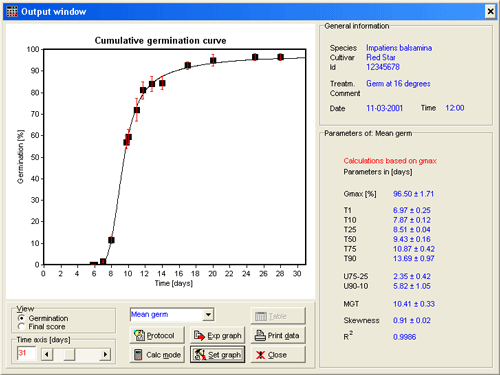 Prof.
Evert Jacobsen Prof.
Evert Jacobsen
Scientific Director
Plant Research International and Wageningen University, Plant
Sciences*
The Netherlands
How can
information technology make seed companies more successful, and
what specific solutions does your company offer?
While it may be fair to say that the use of information
technology has not always been given the highest priority in the
seed business, the last decade has offered a number of fresh
perspectives. When it comes to mathematics, the evaluation of
field trials and of the value of trial fields have become more
effective. Total quality management in seed production has only
become possible thanks to the automation in logistics. In
addition, the seed business had (and still has) to take into
account the way its partners and customers have integrated IT
within their businesses. Research in Wageningen has certainly
contributed to some important new IT-angles for the seed
business. Here, I would like to focus on current and future
perspectives.
Opening up black boxes for breeders
For an effective breeding process, breeders often had to focus
on the phenotype of the progeny. Indeed, the general and
specific combing ability are included in the choice of parents.
However, breeders often have very little idea about the genetic
background of certain traits, and certainly not of the metabolic
background. The plants were like a black box: we saw the
effects, but we didn’t know their source.
Wageningen has been at the forefront of the development and
application of genomics and bioinformatics. As well as serving
fundamental research, this work benefits plant breeders at
institutes and private enterprises worldwide. Once we know the
origin of the trait, we can multiply the possibilities for its
exploitation. An exciting example is the future combination of
different pest or disease resistance mechanisms in a single
variety. I expect some dramatically positive effects on the
durability of the resistance.
User-friendly genetic mapping
From the outset of gene mapping using molecular markers,
Wageningen has been developing genetic mapping software.
JoinMap®, a co-production of Plant Research International and
Wageningen University, now has thousands of users at breeding
companies and institutes around the globe. Various publications
and informal responses from our users make clear that the
programme remains an essential ingredient for success. Since
1993, we have continuously adapted the programme to user
requirements and to new techniques in mathematics and molecular
analysis.
As a result, our latest version, JoinMap® 3.0, can handle a wide
range of mapping populations and offers data export to other
platforms. The user interface can be regarded as one of the best
in genetic mapping software. Our partnership with Kyazma, a
software company in Wageningen, guarantees continuation of the
development and support.
Combining breeding and mapping? FlexQTLTM!
In the 1990s, molecular techniques reached the point where seed
business and research institutes could also map quantitative
traits. Wageningen filled the gap with the MapQTL® package.
Version 5 combines multiple mapping techniques with attractive
graphic presentation of results, a fast algorithm, a
user-friendly windows interface and export to both Office
software and JoinMap®. This allows thousands of users to include
QTL-mapping in their existing work. Our collaboration with
Kyazma again guarantees continuous development of the package.
Despite all of this, our customers and partners asked for more.
Breeders told me they wanted to use their regular breeding
programme for mapping purposes, rather than carrying out
dedicated mapping experiments alongside the breeding programmes.
They also explained how they would also like to include data
from earlier trials, preferably including morphological data.
The Plant Research International response was to develop
FlexQTLTM. Breeders can now commission us to use the data from
their ongoing selection trials to also map quantitative traits
by tracing important alleles across multiple generations. The
cost reductions are substantial and the package brings new
perspectives for breeders who were previously unable to carry
out separate mapping experiments
SeedCalulator®: optimal seed testing
Seed companies, testing stations and researchers evaluating
germination tests have adopted SeedCalculator as an easy to use
package for effective evaluation of germination tests. Users
only have to score the amount of seeds that have germinated and
the time at which the scoring was done. The software performs
the fit that describes the germination curve and the germination
parameters are calculated and presented. Technicians do not need
to be skilled in statistical analyses for these tests.
|
 |
|
Typical
output of SeedCalculator: germination curve and calculated
parameters. |
Other packages are not dedicated to fit germination data in an
easy way. Furthermore, SeedCalculator makes it easy to compare
germination tests from different testing sites, because the
calculations are standardised. A new package, which also will
include predictive information on germiniation under different
temperatures and soil moisture contents, is now being developed
at Plant Research International.
Setting up
and evaluation
We know that mathematics and statistics are not the favourite
disciplines of many of our breeding and seed production
customers. Drawing conclusions without fooling oneself is
essential for success, however. We therefore have specialised
scientists advising customers based on their aims, trial set-up
and data.
The impact of the customers’ IT
It is of course important to take into account the level and use
of automation at one’s customers. Because produce quality and
timing are crucial to the success of today’s growers, they are
keen to explore the possibilities of steering their crops in a
way that optimises economic yield. Computer-based decision
support systems such as those developed in Wageningen allow
growers to combine actual data from the market with the status
of their crops. The computer then offers the grower suggestions
regarding the use of growth conditions such as nutrition and
temperature. This will be quite a challenge as it relies on
varieties responding in a precisely predictable way. Imagine a
cucumber variety for which the growth can be controlled in such
a way that the grower can be certain of the duration of
production, the production peaks and lulls , the position of the
fruits in the crop and the quality of the produce.
Expecting the unexpected
Research institutes such as Plant Research International
continuously push back the boundaries what is possible. Five
years ago I could not have predicted the impact that the
combination of up scaling of genomics technologies and
developments in bioinformatics would have. Partners and
customers can now ask questions they could not have thought of
back then.
It is my firm belief that IT can help the seed business meet its
goals and ambitions, and it might just be in an unexpected way.
*both
Plant Research International and Wageningen University, Plant
Sciences are part of Wageningen UR, The Netherlands.
The Plant Sciences Group of Wageningen UR is a collaboration of:
- Plant Research International B.V.
- Applied Plant Research (Praktijkonderzoek Plant & Omgeving
B.V.)
- Wageningen University
Prof. Evert Jacobsen can be reached at
evert.jacobsen@wur.nl
For more information about Plant Research International, Inc.,
please visit
www.plant.wageningen-ur.nl
May 2004 |